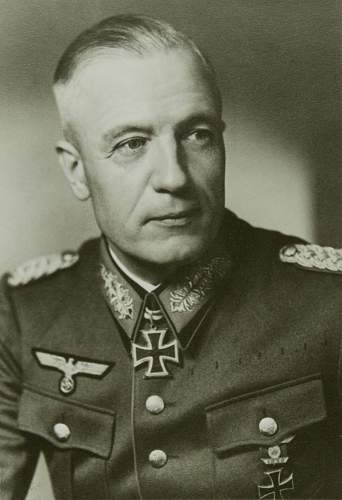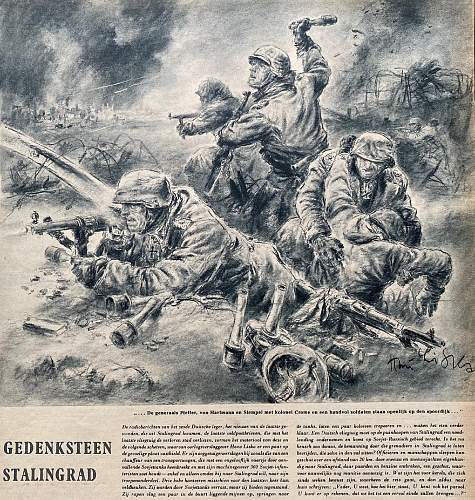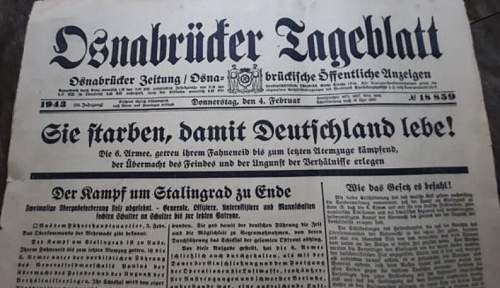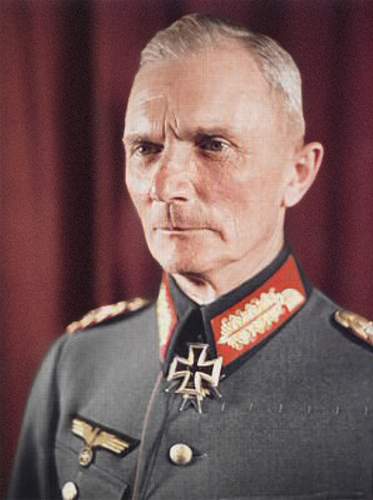The Kaiser's men’s medals
Article about: The Kaiser's men’s medals (and Homelands) Some time ago acquiring this postcard for my collection. It’s a small piece of art on paper that someone used on April 21, 1916 It’s an incred
-
04-25-2024, 08:12 PM
#391

But Gerd von Rundstedt was also a father....

The father of Leutnant Dr. Hans Gerd von Rundstedt (Kassel, January 21,1903- Hannover, December 1, 1948)

Hans Gerd was Generalfeldmarschall only child.
Breaking from the family tradition Hans Gerd become an academic. He achieved a doctorate in the early 30s and worked as archivist in Berlin University. Called up for military service in 1939, was asigned to the Army high Command Historical Section in Berlin. On 1 May 1945 he was captured with his father, and he elected to accompany his father throughout his captivity to British POW camps. Years later his father said he was a lousy soldier......

On May 1, 1945, Marshal Gerd von Rundstedt, former commander-in-chief of German forces on the Western Front, was captured in Bad Tölz, Bavaria, by American troops of the 36th Infantry Division along with his son, Hans von Rundstedt.
Photograph taken in Augsburg on May 6, 1945.
From left to right: Lieutenant Dr. Hans Gerd von Rundstedt, Generalfeldmarschall Gerd von Rundstedt and Lieutenant General Alexander "Sandy" Patch, Jr (Commander of the US 7th Army).
Of them, the German marshal was the oldest (69 years old), but fate determined that he outlived the other two.
General Patch died a few months after this photo was taken, precisely on November 21, 1945. (pneumonia, just two days before his 56th birthday)
The Marshal's only son, Hans, died on January 12, 1948 from throat cancer (days before his 44th birthday).
Gerd von Rundstedt himself died five years later (in 1953) at the age of 77, due to the heart disease he suffered from. Several months earlier he had also lost his wife, Luise "Bila" von Goetz, who died in October 1952.
Last edited by TabsTabs1964; 04-25-2024 at 11:21 PM.
-
04-25-2024, 08:19 PM
#392
-
04-27-2024, 10:55 AM
#393

Friedrich (Bertram) Sixt von Armin (1851 –1936) was a German general who participated in the Franco-Prussian War and the First World War.

Friedrich Sixt von Armin 1851-1936
Friedrich Sixt von Armin At the age of 19 he served as a cadet in the 4th Grenadier Regiment of the Guards, he was seriously wounded at the Battle of Gravelotte. He was awarded the EK2 and promotion to Second Lieutenant.

Guard Regiments charge at St. Privat

Monument Saint Privat la Montagne dedicated to another of the Guard regiments participating in the attack (the 3rd Guard)
In the latter, he participated in many battles on the Western Front, including the Battles of Passchendaele and the Lys...

German parliamentarians visiting the Western Front: General Sixt von Arnim (First left)
He was the father of….
Hans-Heinrich Sixt von Arnim (1890-1952) 113 ID Commandant. Von Armin surrendered following the Battle of Stalingrad in 1943 and died in Soviet captivity on 1 April 1952.

Hans-Heinrich Sixt von Arnim 1890-1952
During the First World War he was in command of troops and was most recently employed as a captain on the staff of the 26th Infantry Division.
In the Reichswehr he was promoted to lieutenant colonel in 1932, to colonel in 1934 and to major general in 1938. At the time of the invasion of Poland he became chief of staff of the 5th Army. On September 25, 1939, he took over as commander of the 95th Infantry Division. As such, he was promoted to lieutenant general on March 1, 1940.
At the beginning of June 1942 he took over the 113th Infantry Division, which he led into the Battle of Stalingrad. Here he was taken prisoner by the Soviets on January 20, 1943, where he became a close confidant of Friedrich Paulus. He died as a prisoner of war in the Soviet Union in 1952.

-
04-27-2024, 11:07 AM
#394

Karl Leonhard Alexander von Seydlitz-Kurzbach (1847 – 1935) Prussian soldier who achieved the rank of Generalleutnant.
Unfortunately I haven't found any images of him.
Coming from the cadet corps, Seydlitz was transferred to the Magdeburg Fusilier Regiment No. 36 of the Prussian Army as a Standard-bearer on April 18, 1865. There he was promoted to second lieutenant in mid-November 1865 and the following year took part in the battles of Nachod, Skalitz and Königgrätz as well as the battle of Schweinschädel during the war against Austria. His behavior was recognized by the award of the Red Eagle Order IV Class with Swords.
In the war against France, Seydlitz fought at Mont Valérien during the siege of Paris in 1870/71 and received the Iron Cross, Second Class.


Commemorative medal of the War of 1870/71 with several clsps, the one below "MONT VALERIEN"
The Battle of Mont Valérien. On 19 January 1871, the day after Wilhelm I was proclaimed German Emperor, the French General Louis Jules Trochu attacked the Germans west of Paris in Buzenval Park. The attackers seized the town of Saint-Cloud, coming close to the new Emperor's headquarters at Versailles. Trochu was able to maintain his position at St. Cloud for most of the day, but the failure of other French forces to hold their positions left him isolated and the Crown Prince's army was able to force Trochu's salient back into Paris by the next day. This was the last effort to break out of Paris. Trochu turned over command of the Paris defenses to Joseph Vinoy who surrendered the city ten days later.

Episode of the Battle of Mont Valerien
-
04-27-2024, 11:14 AM
#395

He was the father of...
Walther (Kurt) von Seydlitz-Kurzbach (Hamburg, August 22, 1888 – Bremen, April 28, 1976)

Walther von Seydlitz - Kurzbach (1888 - 1976)
In December 1939, Seydlitz (51 y.o.) was promoted to major general. In March 1940 he was appointed commander of the 12th Infantry Division which he led in the De France campaign.
He won the Knight's Cross of the Iron Cross and remained in France with his division as an occupying force until 1941. In June 1941, his division participated in the attack on the Soviet Union as part of the 16th Army. In December 1941 he was promoted to lieutenant general and awarded the Oak Leaves.

In March 1942, he became leader of the Seydlitz group with the task of opening from the outside the Demyansk pocket, in which almost 100,000 men were trapped.



At the beginning of April, it was possible to reestablish land communication with the enclosures (Unternehmen Brückenschlag). This success earned Seydlitz his promotion to General der Artillerie in June 1942 and his appointment as commanding general of the LI. Army Corps.

The LI Corps, belonging to Colonel General Friedrich Paulus's 6th Army, participated in the German attack on Stalingrad in September 1942. It was surrounded along with the rest of the 6th Army in November 1942.
Among Stalingrad's senior generals, no one called for a departure from the Kessel as emphatically as Seydlitz. With the collapse of the 6th Army, the Soviets took him prisoner on January 31, 1943,

Early February 1943, Soviet prisoner of war
As a Soviet prisoner of war, Seydlitz was at the founding of the Association of German Officers (BDO) and became its president.
Eleven of Stalingrad's 22 generals (including Field Marshal Paulus) joined the BDO. Two months after its founding, the BDO joined the National Committee for a Free Germany (NKFD), an association of German prisoners of war with exiled German communists, as an independent organization. He campaigned in vain to set up a corps of captured German soldiers to fight on the side of the anti-Hitler coalition.
In January 1949, Seydlitz requested repatriation to the Soviet occupation zone. However, he was not released, but was sentenced to death by a Soviet military court, but later commuted the sentence to 25 years in a camp.
When the last ten thousand prisoners of war returned home in 1955, Seydlitz was also liberated in the Federal Republic of Germany. In 1956, the Verden regional court annulled the death sentence imposed by the Third Reich. He died in Bremen at the age of 87.
-
04-27-2024, 11:46 AM
#396
-
04-27-2024, 11:58 AM
#397


In total, from January 10 to February 22, 1943, 91,545 people were captured within the city limits of Stalingrad. Among them, the following general officers:
Field Marshal Friedrich Paulus, commander of the 6th Field Army of the Wehrmacht. Captured near Stalingrad on January 31, 1943.
Max Karl Pfeffer, Lieutenant general of artillery, commander of the 4th Army Corps of the 6th Field Army of the Wehrmacht. Captured near Stalingrad.
Walter Heitz, Colonel General, commander of the 8th Army Corps of the 6th Field Army of the Wehrmacht. Captured near Stalingrad. He died in captivity in 1944.
Karl Strecker, Colonel General, commander of the 11th Army Corps of the 6th Field Army of the Wehrmacht, commander of the northern group of German forces at Stalingrad. Captured in the Stalingrad area on February 2, 1943.
Walter Alexander von Seydlitz-Kurzbach, General of Artillery, commander of the 51st Army Corps of the 6th Field Army of the Wehrmacht. Captured in Stalingrad on January 31, 1943. He was one of the supporters of an unauthorized escape from the encirclement. President of the Union of German Officers.
Hans Wultz, Major General, Chief of Artillery of the 4th Artillery Corps of the 6th Field Army of the Wehrmacht. Captured at Stalingrad on January 30, 1943.
Ulrich Fasel, Major General, Chief of Artillery of the 51st Army Corps of the 6th Field Army of the Wehrmacht
Werner Schlömmer, Lieutenant general, commander of the 14th Panzer Corps of the 6th Field Army of the Wehrmacht. Captured near Stalingrad.
Arthur Schmidt, Lieutenant general, chief of staff of the 6th field army of the Wehrmacht. Sentenced to 25 years in prison, in October 1955 he returned to Hamburg, where he lived for the last few years.
Otto-Karl Wilhelm Renoldi, Brigadier General of the Medical Service, Chief of the Medical Service of the 6th Field Army of the Wehrmacht. Captured at Stalingrad on January 28, 1943.

Sixtus von Arnim, Lieutenant general, commander of the 113th Infantry Division of the 6th Field Army of the Wehrmacht. Captured near Stalingrad.
Alexander Maximilian von Daniels, Lieutenant general, commander of the 376th Infantry Division of the 6th Field Army of the Wehrmacht. Captured at Stalingrad on January 29, 1943. Vice President of the German Officers' Union, created from prisoners of war in September 1943.
Heinrich Anton Deboy, Lieutenant general, commander of the 44th Infantry Division of the 6th Field Army of the Wehrmacht. Captured at Stalingrad on January 28, 1943.

Moritz von Drebwehr, Major General, commander of the 297th Infantry Division of the 6th Field Army of the Wehrmacht. Captured near Stalingrad.
Otto von Corfes, Lieutenant general, commander of the 295th Infantry Division of the 6th Field Army of the Wehrmacht. Captured at Stalingrad on January 31, 1943.

Erich Albert Magnus, Major General, commander of the 389th Infantry Division of the 6th Field Army of the Wehrmacht. Captured at Stalingrad on February 1, 1943.

Karl Rodenburg, Lieutenant general, commander of the 76th Infantry Division of the 6th Field Army of the Wehrmacht. Captured near Stalingrad.
Fritz Georg Roske, Major General, commander of the 71st Infantry Division of the 6th Field Army of the Wehrmacht, commander of the southern group of German troops at Stalingrad. Captured on January 31, 1943.
Hans Georg Leiser, Lieutenant general, commander of the 29th Motorized Division of the 6th Field Army of the Wehrmacht. Captured at Stalingrad on January 31, 1943.
Martin Wilhelm Lattmann, Lieutenant general, commander of the 14th Panzer Division of the 6th Field Army of the Wehrmacht. Captured at Stalingrad on February 1, 1943
Arno Richard von Lenski, Major General, commander of the 24th Panzer Division of the 6th Field Army of the Wehrmacht. Captured at Stalingrad on February 2, 1943.
Constantin Britescu, Brigadier General, commander of the 1st Romanian Cavalry Division. Captured near Stalingrad.
Romulus Dimitriu, Brigadier General of the Romanian Army, Commander of the 20th Infantry Division. Captured near Stalingrad.
Gunter Angern, Commander of the 16th Panzer Division. He shot himself on February 2, 1943 and thus escaped capture.

When the end in Stalingrad was approaching, each division was ordered to fly out their best and most experienced officers.
Among the high-ranking officers evacuated from the siege, the following stand out:
Oberst Johannes Schmidt - Kommandeur Infanterie regiment 191
Flew out: exact date unknow end November - early December 1942
During the rest of the war, he achieved the rank of Generalmajor (post)
Oberst Eberhard Thunert– Chef Generalstab XIV. Panzer Korps
flew out: in the evening of 13 January 1943 - ordered to
During the rest of the war, he achieved the rank of Generalleutnant
Oberstleutnant Oskar Mäder - Kommandeur I.R. 522
flew out: in the evening of 22 January 1943
During the rest of the war, he achieved the rank of Generalmajor
Oberst Rudolf Sieckenius - Kommandeur Panzer Regiment 2
flew out: during the night of 19 and 20 January 1943 – wounded
During the rest of the war, he achieved the rank of Generalmajor
Oberst Wilhelm Arnold - Armee Nachrichtenführer AOK 6
Flew out: 1 January 1943
During the rest of the war, he achieved the rank of Generalmajor
Oberstleutnant Willy Langkeit - Kommandeur Panzerregiment 36
Flew out: in the evening of 19 January 1943 (Same flight than Generaloberst Hans Valentin Hube)
During the rest of the war, he achieved the rank of Generalmajor
Not all of the German generals encircled at the Stalingrad Kessel were captured by the Soviets. Colonel General Hans-Valentin Hube was flew out by plane (by personal order of the Führer)


Colonel General Hans Valentin Hube
Last edited by TabsTabs1964; 04-27-2024 at 12:48 PM.
-
04-27-2024, 12:04 PM
#398

Let's take a closer look at some of them in this group of photos from very early in February 1943.

Photo 1
1. (Left facing right) is Generalleutnant of artillery Max Karl Pfeffer, commander of the 4th Army Corps.
2. (Left with dark Winter fur cap, facing front) is Major General Ulrich Fasel, Chief of Artillery of the 51st Army Corps.
3. (Center with Feldmütze facing right) is Major General Erich Albert Magnus, commander of the 389th Infantry Division.
4. (Center with peaked cap, facing front) is Lieutenant General Hans Georg Leiser, commander of the 29th Motorized Division. Captured at Stalingrad on January 31, 1943.
5. (Right with light winter fur hat, facing down) is Major General Arno Richard von Lenski, commander of the 24th Panzer Division.
6. (Right, with peaked cap and monocle, facing front) is Generalleutnant Carl Rodenburg of the 76th Infantry Division; he was released from captivity on January 10, 1955.

Photo 2
3. (Left with Feldmütze facing right) is Major General Erich Albert Magnus, commander of the 389th Infantry Division.
4. (Left with peaked cap, facing front) is Lieutenant General Hans Georg Leiser, commander of the 29th Motorized Division. Captured at Stalingrad on January 31, 1943.
5. (Center with light winter fur hat, facing down) is Major General Arno Richard von Lenski, commander of the 24th Panzer Division.
6. (Center, with peaked cap and monocle, facing left) is Generalleutnant Carl Rodenburg of the 76th Infantry Division; he was released from captivity on January 10, 1955.
7. (Center, with “crusher” hat, facing left) is Generalmajor Martin Lattmann of the 14th Panzer Division; he was released from captivity in 1948.
8. (Right, in mountain cap) is Generalleutnant Werner Sanne of the 100th Jäger Division.
9. (Right, with crusher hat, in background) is Generaloberst Karl Strecker of the XI Corps.

Photo 3
6. (Left, with peaked cap and monocle, facing right) is Generalleutnant Carl Rodenburg of the 76th Infantry Division; he was released from captivity on January 10, 1955.
7. (Left, with “crusher” hat, facing left) is Generalmajor Martin Lattmann of the 14th Panzer Division; he was released from captivity in 1948.
8. (Center, in mountain cap) is Generalleutnant Werner Sanne of the 100th Jäger Division.
9. (Right, with crusher hat, facing left) is Generaloberst Karl Strecker of the XI Corps.

Photo "Hanmade Collage". From left to right:
1. Generalleutnant of artillery Max Karl Pfeffer, commander of the 4th Army Corps.
2. Major General Ulrich Fasel, Chief of Artillery of the 51st Army Corps.
3. Major General Erich Albert Magnus, commander of the 389th Infantry Division.
4. Lieutenant General Hans Georg Leiser, commander of the 29th Motorized Division.
5. Major General Arno Richard von Lenski, commander of the 24th Panzer Division.
6. Generalleutnant Carl Rodenburg of the 76th Infantry Division; he was released from captivity on January 10, 1955.
7. Generalmajor Martin Lattmann of the 14th Panzer Division.
8. Generalleutnant Werner Sanne of the 100th Jäger Division.
9. Generaloberst Karl Strecker of the XI Corps.
-
04-27-2024, 12:09 PM
#399
-
04-27-2024, 12:35 PM
#400

I have left another German general for last, in this case killed in combat in the final days of the Battle of Stalingrad.....
(Heinrich Eberhard) Alexander von Hartmann (December 11, 1890, Berlin – January 26, 1943, near Stalingrad)

Alexander von Hartmann (1890 – 1943)
At the outbreak of World War II, he led his regiment in the French campaign. After his promotion to major general, on 28 March 1941 was appointed commander of the 71st Infantry Division.
On December 1, 1942 he was promoted to lieutenant general.
Now an image corresponding to the Ritterkreuz award ceremony for Generalmajor Alexander von Hartmann (Kommandeur 71. Infanterie-Division), which was held on October 8, 1942 in Stalingrad.

The two generals who put the medal are: General der Artillerie Walther von Seydlitz-Kurzbach, commander of the LI. Armeekorps and General der Panzertruppe Friedrich von Paulus, Oberbefehlshaber 6. Armee.

The same ones in this other image. Both decided to surrender and were taken prisoner by the Soviets. Furthermore, from the beginning of their captivity they renounced their oath and publicly embraced the ideas of their captors, against all their comrades in arms....
Alexander von Hartmann did not. He acted differently...

He was killed on January 26, 1943 on the embankment of the Tsaritza railway in a firefight with Soviet soldiers.
When all hope was lost, Hartmann spoke to his officers calmly: "It’s a great honor when an officer died in a battle. I will not kill myself, but I will sell my life dearly."
He then took the rifle and headed for the embankment of the Stalingrad train located in the south. In front of the remaining members of his division (3 officers, 7 noncommissioned officers, and 183 soldiers), von Hartmann started firing at the Russian soldiers who was invading ... while standing still! At 8:00 a.m. on January 26, 1943, he finally fell as he wished, shot right in the head. Also killed in the same day and in the same embankment were Oberstleutnant Kurt Corduan (Kommandeur Infanterie-Regiment 191) and Major Bayerlein (Kommandeur Infanterie-Regiment 211). Hartmann was promoted to General der Infanterie posthumously on February 15, 1943.

Magazine SIGNAL march 1943 Painting of Hans Liska (Gen. Hartmann, Pfeffer, Stempel & Col. Crome, last fight)

The fighting in Stalingrad has ended...... For some with more honor than for others....
The following will be to talk about some descendants of the most important Prussian character in the entire Second Reich.
Similar Threads
-
In New users approval forum
-
In Medals, Orders & Decorations
-
In Field equipment, kit and other
 Posting Permissions
Posting Permissions
- You may not post new threads
- You may not post replies
- You may not post attachments
- You may not edit your posts
-
Forum Rules







 .
.




















































Bookmarks